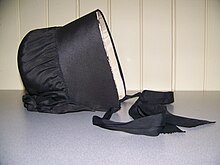Quakers in Upper Canada
The Quakers (Society of Friends) have had a presence in Canada since 1670, when Charles Bayly was sent to be the governor of the Hudson's Bay Company.
Early Quaker settlements were attempted in New Brunswick, Nova Scotia, Prince Edward Island and at Farnham in Quebec in the late 1700s.
A Canadian Quaker sect, the Children of Peace, was founded during the War of 1812 after a schism in York County.
They also served as a receiving station, easing the flow of settlers from east to west and ensuring they had an established network of Friends to turn to.
When an individual Quaker feels led to speak, he or she will rise to their feet and share a spoken message ("vocal ministry") in front of others.
Those who worship in this style hold each person to be equal before God and capable of knowing the light directly.
Friends believed that it was important to avoid fanciness in dress, speech, and material possessions, because those things tend to distract one from waiting on God's personal guidance.
They also tend to cause a person to focus on himself more than on his fellow human beings, in violation of Jesus' teaching to "love thy neighbor as thyself."
[4] Plainness in speech also included affirming rather than making an oath or shaking hands to agree upon a deal, and setting fixed prices for goods rather than bargaining.
The De Long family and nine others, principally from Dutchess County, joined Lossing the same year and by 1820 an additional group of about fifty had settled within the tract.
The Children of Peace (1812–1889) were a utopian Quaker sect that separated from the Yonge Street Monthly Meeting of the Society of Friends (in what is now Newmarket, Ontario, Canada) during the War of 1812 under the leadership of David Willson.
Today, they are primarily remembered for the Sharon Temple, an architectural symbol of their vision of a society based on the values of peace, equality and social justice.
Willson said that he was called in a vision to "ornament the Christian Church with the glory of Israel," which he interpreted to mean as abandoning plainness in meeting houses, and in worship.
The group founded the community of Hope (now Sharon) in East Gwillimbury, York Region, Ontario, where they built their Meeting Houses (places of worship) and the Temple.
It was constructed in imitation of Solomon's Temple and the New Jerusalem described in Revelation 21, and used once a month to collect alms for the poor; two other meeting houses in the village of "Hope" were used for regular Sunday worship.
The Children of Peace, having fled a cruel and uncaring English pharaoh, viewed themselves as the new Israelites lost in the wilderness of Upper Canada; here they would rebuild God's kingdom on the principle of charity.
The Children of Peace were never communal like many of the other new religious movements then sprouting up in the United States (like the Shakers, the early Mormons or the Oneida Perfectionists).
[6] The Children of Peace played a critical role in the development of democracy in Canada through their support of William Lyon Mackenzie; and by ensuring the elections of both "fathers of responsible government," Robert Baldwin and Louis LaFontaine, despite persistent political violence by the Orange Order.
His preaching and teaching precipitated the Great Separation of 1827, which resulted in a parallel system of Yearly Meetings in America and Upper Canada.
With increasing financial success, Orthodox Quakers wanted to "make the society a more respectable body—to transform their sect into a church—by adopting mainstream Protestant orthodoxy".
[8] Hicksites, though they held a variety of views, generally saw the market economy as corrupting and believed Orthodox Quakers had sacrificed spirituality for material success.




